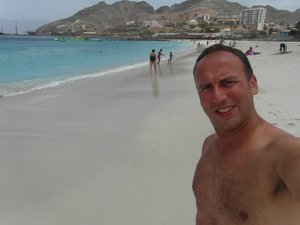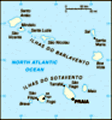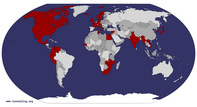Advertisement
Published: August 17th 2017

 Me, Laginha Beach
Me, Laginha Beach
Mindelo, Sao VicenteDear All
Greetings from the island of Sao Vicente, my fourth and final island on my Cape Verdean tour. I really like this island, and I have found its capital city, and main city by far, Mindelo quaint, charming and very characterful. Although it has only been two days since I last wrote a blog entry on Santo Antao, and I have only spent two nights here (though three if you include the brief one I spent here on the way to Santo Antao), I feel I couldn’t do my trip justice without writing a separate blog entry for each of the four islands on my travels, so here is my final one for Sao Vicente.
I last wrote on my final afternoon in Ponta do Sol – I didn’t have a very relaxing final evening and night there, although I did sleep well fortunately. This was because the owner of the B&B I was staying at didn’t confirm to me that he had booked a minibus to come and collect me from there on Wednesday morning to take me back to Porto Novo to catch the morning ferry. His flat is below the B&B, but he was nowhere

 Eagle Monument
Eagle Monument
Mindelo, Sao Vicenteto be found that evening when I wanted to check this with him, and he was also not answering his mobile phone. I found this quite stressful to be honest, but in the end I decided that just going with the flow, waking up the next morning, and seeing what happens from there, was the best way forward, and in fact the only rational way forward. There was actually a French couple staying in the B&B who were also leaving for Porto Novo that morning, and I ended up journeying with them in their minibus – whether this was the one the owner booked for me or not, I guess I’ll never know, though I suspect it wasn’t as the driver seemed surprised at the end of the journey when I told him I still had to pay for the transfer. I since emailed the owner of the B&B, who apologised profusely and explained to me what happened, and his apology I accepted (I shall not be writing that bad TripAdvisor review now…). It still made for an unenjoyable final evening in Santo Antao unfortunately…
Ah well – the minibus drove us quickly to the ferry terminal, from where

 Laginha Beach
Laginha Beach
Mindelo, Sao Vicentethe ferry set off again back for the delightful city of Mindelo. This time the wind was much stronger, and the sea much choppier – it was rather a rough crossing. There was a ferry worker who came around at the beginning handing around sick bags, and there were again a number of children around me being sick for the journey. Fortunately I was not affected, and enjoyed finding my sea legs again – as long as it’s not too hairy, I generally enjoy the motion of being on the sea, and feel I could definitely be a sailor in another life.
Upon arrival, I collected my backpack from the communal luggage store area, and trekked the short journey to the Residencial Che Guevara, the wonderful place I stopped the night in briefly on Saturday evening. This has to be the best of the hotels I have stayed in on my West African trip so far. The family owners are super friendly, efficient, helpful and always available. And the place is a wonderful, rambling building with lots of hidden nooks and crannies, and secret staircases. The room is also highly comfortable, with everything there already, and I believe this

 Fish Market
Fish Market
Mindelo, Sao Vicenteis the first time on my trip that I have not had to ask for anything extra: toilet roll, soap, blankets, air-conditioning remote – they are all here, what joy! The breakfast is copious and delicious, and there is an old sense of rustic charm to the place. I am very much enjoying my stay here.
In addition, Mindelo is also such a lovely place to spend time in. Whilst Praia is Cape Verde’s political and economic centre, as well as its largest city of around 150,000 people, Mindelo is referred to as the country’s cultural centre. With only around half of Praia’s population, at around 70,000 people, it actually feels more cosmopolitan, more big-city like, with swish restaurants, a buzzing and well-to-do atmosphere, a modern marina filled with huge and beautiful yachts, and a beautiful white-sanded beach too. It feels more like being in a small Mediterranean coastal resort, than on a parched, (literally) desert island in the middle of the Atlantic Ocean.
Indeed, Sao Vicente is genuinely a desert island – no rain falls here. The whole archipelago is considered an island extension of the Sahel area of Africa, parched, dry and receiving less and less
rainfall as the years go by. Rain does still fall on Santiago, Fogo and Santo Antao. However, the elderly here on Sao Vicente apparently tell of the days when rain used to fall, but now it is very rare indeed. The island’s water supply is now gained from the process of desalination, which is apparently very expensive, so everyone is encouraged to save and not to waste water. A drive around the island today revealed, beyond the comparatively wealthy urban conurbation, a dry and parched land, more akin indeed to the border regions surrounding the Sahara desert than the well-watered ribeiras of Santo Antao. It really is quite a wonder how any settlement, let alone such a happening place, as Mindelo, exists on such an island.
The answer to this riddle actually lies with the island’s main economic resource: its harbour. Mindelo’s harbour is the safest and best equipped of the whole country’s, so much so that international cruise ships, as well as many afore-mentioned yachts, are able to dock here. Most of the coasts of this country are dangerous, with powerful waves, strong currents, and hidden offshore rocks and reefs. Mindelo’s harbour, however, is protected by two headlands
at either end, and the city is also protected from strong winds by the mountains which surround it. Such a beneficial setting did not go unnoticed during the rapid European expansion of industrialism and colonialism in the 19
th Century, and to my great surprise I have learned here that it was the English who first developed this area into the important centre that it is today. From the early 1800s, Mindelo became a refuelling centre for coal-powered ships, travelling from Europe to South America or Southern Africa. Coal was regularly shipped in from Cardiff. By the late 1800s, the Royal Mail had set up office here, presumably as a station point in cross-Atlantic journeys, and in 1875, Sao Vicente was also chosen as the site for the submarine cable which allowed trans-Atlantic telecommunication. As a result, numerous shipping and customs buildings, and colonial British houses, were built here, and still remain today. In fact, a wander around the centre of town yesterday revealed to me just how many English-looking houses there are here, with sloping roofs, often with a window built into them. The island-tour around the island also took me past a tiny settlement called Mato Ingles, or English

 Ilheu dos Passaros
Ilheu dos Passaros
Mindelo, Sao VicentePlace, with small, English-looking houses built halfway up the highest mountain on the island, Mt Verde, in a setting not entirely dissimilar from rolling country hills, with a bit of mist adding to the coolness of the atmosphere there. The island-tour also took me to a fascinating Golf Club, which was originally built by the British in 1893, and I presume it was originally grassed. Today it claims to be one of the world’s largest non-grass courses in the world, and indeed was rather dusty. It was a very surreal, yet also very endearing, sight watching two elderly, Cape Verdean gentlemen, kitted out in golfing gear and attire, making their way around the dry, dusty course.
Sadly, as my guidebook says, as world events changed towards the end of the 19
th century and the early 20
th century, Mindelo and Sao Vicente simply failed to keep up. The Suez Canal was constructed in 1869, which reduced the need for ships to refuel in Cape Verde. Ships’ bunkers became larger, reducing anyway the need for refuelling. And telecommunications also developed, as the cable connection became mechanised, reducing the need for English telegraph staff in Cape Verde. All of this led to

 Laginha Beach
Laginha Beach
Mindelo, Sao Vicentea decline in the city, an increase in its reputation for poverty, and a connotation with the typical, rough nature of port cities around the world, even in some places to this day. Mindelo is indeed said to have a bit of an edge to it, and hotels advise taxis home in the evenings. However, although I have not been out in the evenings, I have not felt any edginess since being here, and I do believe the Cape Verdean government has done much today to promote the plight and existence of the city. Cesaria Evora, the country’s favourite singer, was born here, her memory and legacy living on throughout the city, an international airport has recently been built, along with the country’s safest and largest port, and the Laginha Beach in the north of town has had a facelift, and despite being right next to the port, could in fact be a beach from any white-sanded, azure-watered Caribbean island to my mind.
I have spent these last two days enjoying getting to know Mindelo and Sao Vicente. Yesterday, after arriving by ferry and checking in once more to the same, comfortable room here at the Residencial Che Guevara,

 Marina
Marina
Mindelo, Sao VicenteI did a delightful walking tour of the city centre, admiring the view over the modern harbour and its yachts, taking numerous photos of the city’s photogenic colonial (British!) buildings, and enjoying the street-café vibe here. This morning, I did an island tour with an interesting gentleman, Paolo, and his driver Freddy. Paolo is Capeverdean, though spent some time living in “Bworston”, Massachusetts, before returning here with his American wife and four children. His Boston accent was palpable, and he spoke very loudly, quickly and allowing little time for any kind of response. I have noticed a number of such people around here, there are apparently a good number of Capeverdeans who have emigrated to Massachusetts, some of them presumably returning back to the islands to either visit or to live again. Paolo took me around the main sights of the city (again!), though this time to include the fort, fish market and African market – I was happy to be in these places with Paolo, rather than alone, as he seemed to know everybody, and it felt absolutely fine taking photos, with no hassle whatsoever. Paolo seems to be some kind of wide-boy around here, he was known by

 Marina, Mindelo
Marina, Mindelo
Monte Cara can be seen in the background on the right, resembling the face of a man lying downeverybody, doing a special handshake with each one, and possessing some remarkable tattoos akin to some kind of gangster-style past (including pistols, and initials on knuckles). I am sure he has some stories to tell of his time in the USA. Although very loud and talkative, I actually got to quite admire the guy – he seemed very honest and very decent, and very happy to have just begun his tour business “Green Line Tours”, named by his daughter after the tube line they used to live on in Boston, and related also to the “Verde” of “Cape Verde”. He had just bought his own minibus, and he and his driver both sported “Green Line Tours” matching t-shirts. It was endearing to sense his pride in his achievements here, and I wish him all the best with it (again, “Green Line Tours”, just in case anybody reading this may be visiting and may be interested…!).
After seeing the main sights of Mindelo, we drove out to the Golf Club, and then through the desert interior of Sao Vicente. Remarkably, 97% of the population of Sao Vicente live in Mindelo, leaving only 3% for the rest of the island –

 Torre de Belem
Torre de Belem
Mindelo, Sao Vicenteone can imagine how sparse and desolate the rest of the island is. The visitor who only visits Mindelo would have no idea of the desert island nature of Sao Vicente. We drove through some very stark and arid scenery, feeling thirsty just looking out at it, and wondering again how such a city of Mindelo can have been founded here (again, though, the answer lies in its strategically important port and harbour). We drove to the tiny fishing village of Calhau on the east coast of the island, and then on from there along a spectacular coastal road northwards running alongside the magnificent beach of the Praia Grande, including a large Sahara-style sand dune. This took us to another tiny village called Baia das Gatas, which is actually the site of Mindelo’s second most important annual festival, after February’s Carnival, called the Baia das Gatas festival. This festival takes place over a weekend, around the time of the full moon in August. It actually took place this year last weekend, and on the Saturday I arrived it was actually in full swing. However, and of course to those who know me, due to my quiet nature, music festivals are

 Biblioteca Municipal
Biblioteca Municipal
Mindelo, Sao Vicentecertainly not my scene, and I did nothing that evening except go to bed and wake up the next morning to take the ferry to Santo Antao. It was interesting to visit the beach where the festival took place though, just four days ago, and the music stage was still up there on the wide expanse of sand stretching out into a huge shallow bay of clear, warm water. It must have been quite a setting for such a music festival, but again, very glad I didn’t go, definitely not my thing.
From Baia das Gatas, we returned back to Mindelo, via a drive up the island’s highest peak, Monte Verde, at 750m – the air was cool and crisp up there, with cloud and mist, and felt a very refreshing treat from the heat of the city. Paulo also pointed out some more English houses to me up there, and I could just about see the area’s appeal to my country-folk, longing for rolling, vaguely green, mist–shrouded hills on a tropical desert island in the middle of the Atlantic Ocean…! Paolo also told me of some words in the Portuguese Creole language spoken in Cape Verde which derived
from the English influence, a number of them ending in “up”, such as
ariope (hurry up),
chatope (shut up) and
fulope (full up). But my favourite English-derived Creole word has to be
blaquefela, meaning “a person of more African heritage”. I actually also thought people around here were speaking English to me when they said
tanquiu or
tanks, but in fact these are also English-derived Creole words – who’d have known…?!
So I have indeed enjoyed my (brief) time here on my final Cape Verdean island. Today is my final full day in this country. Tomorrow morning I fly back to Praia, spending the day there after having booked myself in for a half-day back at the Residencial Nazare, before taking an evening flight back to Dakar, and the African mainland again. I have thoroughly enjoyed my time here on this island nation, what a fascinating and beautiful country it is! It seems a shame that most people’s experience of Cape Verde is of a package holiday to either Sal or Boavista, where I have heard there really isn’t much to do, and that one should take a good book or five. There is so much that this country
can offer, and I feel like I have had a wonderful taster of the amazing, and surprising, variety of attractions here. The people are extremely warm, hospitable and super-friendly, and I believe I am going to miss what the locals refer to as “morabeza”, which apparently translates as “hospitality” or “welcoming”. I have certainly been made to feel welcome here, thank you very much Cape Verde for having me 😊
So tomorrow I fly back to Dakar, and on Saturday I plan to head up to the old French colonial town of Saint-Louis in the north of the country. I plan to spend three nights there, before my final two nights in Dakar, taking me up to my return flight home back to London, via Madrid, next Thursday evening, arriving back Friday morning. I plan to write up my next one either from Saint-Louis whilst there, or from Dakar upon my return again.
So in the meantime, thank you again for reading, and wishing everyone, along with Cape Verde, a fond farewell – until the next time, ate logo!
Alex
Advertisement
Tot: 0.225s; Tpl: 0.04s; cc: 13; qc: 32; dbt: 0.0662s; 1; m:domysql w:travelblog (10.17.0.13); sld: 1;
; mem: 1.2mb


















































D MJ Binkley
Dave and Merry Jo Binkley
Sao Vicente
This afternoon I've been reading and rereading your 2017 trip to West Africa. Somehow, I had missed this one. This summer trip certainly offered a varied experience. I'm glad Cape Verde was more enjoyable and not the experiences that Senegal and Gambia were. Its easier to appreciate a nice location after you've been roughing it in other countries.